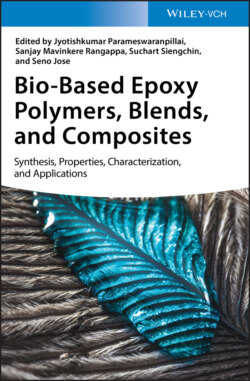Читать книгу Bio-Based Epoxy Polymers, Blends, and Composites - Группа авторов - Страница 2
Table of Contents
Оглавление1 Cover
2 Title Page
3 Copyright
4 Dedication
5 Preface
6 About the Authors
7 1 Synthesis of Bio‐Based Epoxy Resins 1.1 Introduction 1.2 Plant Oil Bio‐Based Epoxy Resins 1.3 Substitutes for Bisphenol A Replacement 1.4 Bio‐Based Epoxy Curing Agents References
8 2 Natural/Synthetic Fiber‐Reinforced Bioepoxy Composites 2.1 Introduction 2.2 Synthetic and Natural Fibers 2.3 Bioepoxy 2.4 Fiber‐Reinforced Bioepoxy Composites 2.5 Future Perspectives 2.6 Conclusions Acknowledgments References
9 3 Polymer Blends Based on Bioepoxy Polymers 3.1 Introduction 3.2 Plant Oils 3.3 Preparation of Bioepoxy Polymer Blends with Epoxy Resins 3.4 Application of Bioepoxy Polymer Blends 3.5 Conclusion References
10 4 Cure Kinetics of Bio‐epoxy Polymers, Their Blends, and Composites 4.1 Introduction 4.2 Fundamentals of Curing Reaction Kinetics 4.3 Curing of Bio‐thermosets 4.4 Curing Kinetics of Bio‐epoxies and Blends 4.5 Case Study: Non‐isothermal Kinetics of Plant Oil–Epoxy–Clay Composite 4.6 Conclusion and Future Prospective References
11 5 Rheology of Bioepoxy Polymers, Their Blends, and Composites 5.1 Introduction 5.2 Rheology of Bioepoxy‐Based Polymers 5.3 Rheology of Bioepoxy‐Based Composites 5.4 Rheology of Bioepoxy‐Based Blends 5.5 Conclusions and Future Scope References
12 6 Dynamical Mechanical Thermal Analysis of Bioepoxy Polymers, Their Blends, and Composites 6.1 Focus 6.2 Bioepoxies and Reinforcers 6.3 Dynamic Mechanical Analysis and Polymer Dynamics 6.4 Applications 6.5 Conclusion References
13 7 Mechanical Properties of Bioepoxy Polymers, Their Blends, and Composites 7.1 Introduction 7.2 Mechanical Properties of Bioepoxy Polymers 7.3 Blends of Bioepoxy Resin 7.4 Bioepoxy‐Based Composites 7.5 Conclusion 7.6 Future Perspectives and Recommendations Acknowledgment References
14 8 Bio‐epoxy Polymer, Blends and Composites Derived Utilitarian Electrical, Magnetic and Optical Properties 8.1 Introduction 8.2 Significance of Bioepoxy‐Based Materials 8.3 Bioepoxy‐Derived Utilitarian Electrical, Magnetic, and Optical Properties 8.4 Conclusion References
15 9 Spectroscopy and Other Miscellaneous Techniques for the Characterization of Bio‐epoxy Polymers, Their Blends, and Composites 9.1 Introduction 9.2 Various Methods for Epoxy Polymer Characterization 9.3 Various Bio‐Based Epoxy Polymers, Theirs Uses, and Methods of Characterization in Review References
16 10 Flame Retardancy of Bioepoxy Polymers, Their Blends, and Composites 10.1 Introduction 10.2 Methods for Analyzing Flame‐Retardant Properties 10.3 Halogen‐Free Flame‐Retardant Market 10.4 Bioepoxy Polymers with Flame‐Retardant Properties 10.5 Use of Fillers for Improving Flame‐Retardant Properties of Bioepoxy Polymers 10.6 Conclusion Acknowledgment References
17 11 Water Sorption and Solvent Sorption of Bio‐epoxy Polymers, Their Blends, and Composites 11.1 Introduction 11.2 Bio‐epoxy Resins 11.3 Conclusion References
18 12 Biobased Epoxy: Applications in Mendable and Reprocessable Thermosets, Pressure‐Sensitive Adhesives and Thermosetting Foams 12.1 Introduction 12.2 Mendable and Reprocessable Biobased Epoxy Polymers 12.3 Pressure‐Sensitive Adhesives (PSAs) From Biobased Epoxy Building Blocks 12.4 Biobased Epoxy Foams References
19 Index
20 End User License Agreement
